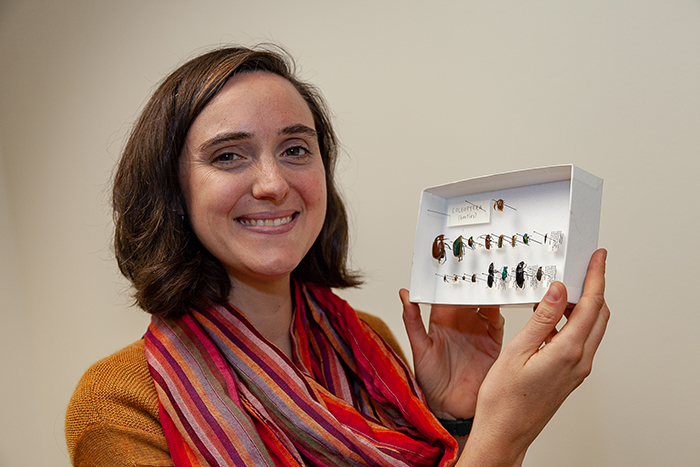Dickinson College Faculty Research Reveals Surprising Information About Pesticide Use

Probing Pesticide
by Kandace Kohr
Though you might think that genetically modifying crops to be insect resistant would decrease the use of potentially harmful insecticides, Assistant Professor of Environmental Studies Maggie Douglas has found the true picture is more complicated. Her research, probing large swaths of data on insecticide use over the last 25 years of U.S. agriculture, reveals that when it comes to genetically modified corn, insecticide use is actually on the rise.
After World War II, U.S. farmers rapidly adopted synthetic pesticides, but without a lot of thought about the effects these compounds might have on creatures beyond the pests they were designed to control. This changed in 1962 when Rachel Carson published Silent Spring. The book was instrumental in identifying, and raising public consciousness about, the environmental effects of pesticide application.
Some of the questions that motivate Douglas’s work are “Have we made any progress since Carson’s time? Have we reduced our use of pesticides or learned to use them more sustainably?” While these questions might seem straightforward, Douglas attests that answers are elusive due to the large and diverse number of pesticides available and the limited nature of data on pesticide use.
By synthesizing large-scale pesticide and crop datasets from the U.S. Department of Agriculture and U.S. Geological Survey, Douglas made her surprising discovery. While many researchers and agriculturalists believe that insect-resistant genetically engineered corn reduced the use of insecticides in the U.S., Douglas found that the area of corn treated with insecticides and the total insect toxicity of insecticides applied actually increased during the era of genetically engineered corn adoption. This finding challenges common understandings of the effects of genetically engineered agriculture and raises concerns about the current effects of pesticides on bees and other nontarget species.
Last summer, Douglas enlisted two students to study patterns of pesticide use and their effects on beneficial insects. Sara Soba ’21 (environmental science) researched insecticide use patterns and created an app to help stakeholders explore patterns of toxic load to bees in different regions of the country. Karan Shakya ’20 (environmental studies, economics) studied how herbicide use in the southern U.S. impacts monarch butterfly populations. Both students recently won awards for their research at the Annual Meeting of the Entomological Society of Pennsylvania. Shakya took first place among undergraduate presentations, and Soba won first place among undergraduate posters.

Sara Soba '21 and Karan Shakya '20 pose with their awards at the Annual Meeting of the Entomological Society of Pennsylvania.
In a country where close to a billion pounds of pesticides are applied to farmland each year, Douglas believes that high-quality pesticide data are a public good, and that further study of the social and economic drivers of pesticide use is essential. “There is true value in interdisciplinarity when it comes to this issue,” she says. “Agriculture is a complex system, and we need natural scientists as well as social scientists to help us solve the pesticide problem.”
Douglas presented her research during her Rush Hour lecture, “Genetically Engineered Crops & Pesticide Use: What is the Relationship?”
Learn more about research at Dickinson.
TAKE THE NEXT STEPS
Published November 9, 2018